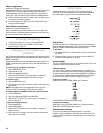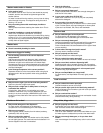
18
Washer makes noise or vibrates
■
Is the washer level?
The washer must be level. The four feet should be properly
installed, and the nuts should be tightened against the
washer cabinet.
As water is drained from the washer, you may hear air being
pulled through the pump. This happens during the end of
draining. It is normal.
■
Are you washing items with metal snaps, buckles or
zippers?
You may hear metal items touching the washer drum. This is
normal.
■
Is washer installed on a sturdy and solid floor?
Refer to the “Installation Instructions” for flooring
requirements. Noise and vibration may be reduced by placing
a piece of ¾ in. (19.1 mm) plywood underneath your washer.
The plywood may extend underneath both washer and dryer
to keep them at equal heights.
Washer leaks
■
Check household plumbing for leaks.
Dispensers clogged or leaking
■
Are the laundry products in the correct dispenser
compartment?
Add the correct amounts of detergent, fabric softener or
liquid chlorine bleach to the correct compartments. Add
powdered or liquid color-safe bleach to the Main Wash
compartment. Be sure to match powdered color-safe bleach
with powdered detergent or match liquid color-safe bleach
with liquid detergent.
■
Is the detergent separator in the correct position?
Separator should be in the front position when using liquid
detergent and in the back position when using powdered
detergent.
Load too wet
■
Did you use the right cycle for the load being washed?
Select a cycle with a higher spin speed.
■
Did you wash a single item or bulky items or have you
overloaded the washer?
A single item, bulky items, or overloading may cause
imbalance. Add items or try to evenly distribute your wet
laundry in the drum, and start a DRAIN/SPIN cycle. If the
laundry is still wet, take half of the load out of the washer and
try again.
Residue or lint on load
■
Did you add detergent to the dispenser?
For best results, add detergent to the detergent
compartment. Do not add detergent to the washer drum.
■
Did you sort properly?
Sort lint givers (towels, chenille) from lint takers (corduroy,
synthetics). Also sort by color.
■
Did you overload the washer?
Do not overload the washer. The washer can be fully loaded,
but not tightly packed. The wash load must be balanced. Lint
can be trapped in the load if overloaded.
■
Check the following:
Was paper or tissue left in pockets?
■
Did you use enough detergent?
Follow manufacturer’s directions. Use enough detergent to
hold the lint in the water.
■
Is your water colder than 70°F (21°C)?
Wash water colder than 70°F (21°C) may not completely
dissolve the detergent.
■
Are you using a low speed wash cycle?
Powdered detergents may not dissolve well in a slow-speed
cycle. For best results, use liquid detergent for slow-speed
cycles such as Delicate, Silk, Wool, and Handwash.
Stains on load
■
Did you add detergent to the dispenser?
For best results, add detergent to the detergent
compartment. Do not add detergent to the washer drum.
■
Did you use enough detergent?
Use enough detergent to remove soil and hold it in suspension.
For best performance, use a High Efficiency detergent.
Follow manufacturer’s recommendations for the type of load
you are washing.
■
Is there above average iron (rust) in water?
You may need to install an iron filter.
■
Did you properly sort the load?
Sort dark clothes from whites and lights.
■
Did you unload the washer promptly?
To avoid dye transfer, unload the washer as soon as it stops.
■
Did you use a fabric softener dispensing ball?
Dispensing balls will not operate correctly with this washer.
Add liquid fabric softener to the fabric softener compartment.
■
Did you use powdered detergent in a low-speed cycle?
Consider using liquid detergent.
■
Did you use Rapid Wash on a large load?
For best results, use Rapid Wash for small, lightly soiled
loads.
Load is wrinkled
■
Did you unload the washer promptly?
Unload the washer as soon as it stops.
■
Did you use the right cycle for the load being washed?
Use the Delicate cycle or another cycle with a low spin speed
to reduce wrinkling.
■
Did you overload the washer?
The wash load must be balanced and not overloaded. Loads
should tumble freely during washing.
Gray whites, dingy colors
■
Did you properly sort the load?
Dye transfer can occur when mixing whites and colors in a
load. Sort dark clothes from whites and lights.
■
Was the wash temperature too low?
Use hot or warm washes if safe for the load. Make sure your
hot water system is adequate to provide a hot water wash.
■
Did you use enough detergent, or do you have hard
water?
Use more detergent for washing heavy soils in cold or hard
water.


















